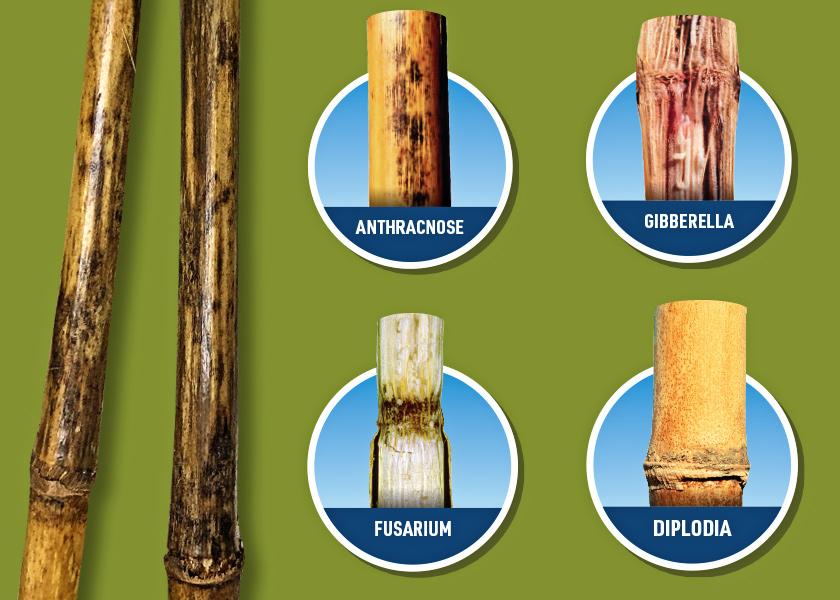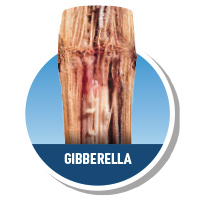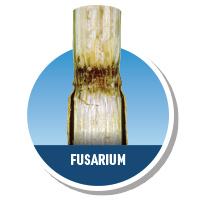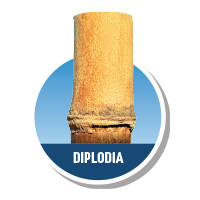Stalk Rots: Be on the Lookout for This Yield Robber at Harvest

Sneaky and quiet, stalk rots can take a big bite out of corn yields. They can go undetected until harvest, and then steal a field’s yield. If it’s a severe attack, rots can rob up to 25% of yield.
“Stalk rots in corn are very difficult to manage, but they are probably our most frequent issue we have in corn pro-duction,” says Nathan Kleczewski, plant disease and insect specialist with Growmark and former University of Illinois Extension field crop plant pathologist.
Yield losses from stalk rots occur because the plant dies a premature death, which equals poor ear fill. Or the dis-eases create harvest losses because stalks break or lodge.
Several types of stalk rots can creep into your fields (see sidebar). Each are caused by a specific type of fungi or bacteria. Stalk rots severity are mostly determined by the level of stress the plant was facing at infection.
High planting density, cloudy weather after pollination and droughty conditions after silking can increase the dis-ease’s impact, Kleczewski says.
SCOUT FOR ROT
After grain fill, start scouting for stalk issues, Kleczewski recommends. Survey at least one site in the field for eve-ry 10 to 20 acres. You can use either of these scouting methods:
- Pinch Test: Pinch the stalk at one of the lowest two internodes. If your thumb pressure causes the stalk to collapse, it fails the test.
- Push Test: Push the stalk to a 30-degree angle (8" to 10" from shoulder height), and if the stalk does not spring back into position, it fails the test.
If you suspect infection, pull plants and split open the stems, adds Connie Tande, South Dakota State University Ex-tension plant diagnostician.
“Look for any weird discoloration, such as pink or white mold,” she says.
If fields have more than 10% to 15% stalks rotted, issues with lodging may occur, Kleczewski says. Prioritize those fields for early harvest.
While stalk rots cannot be prevented, an integrated management approach can reduce their severity.
“The goal is to minimize stress,” Kleczewski says. “Avoid excessive plant populations, which creates water and nu-trient stress. Take a balanced approach to nutrients. Crop rotation can help. Also, use tillage to reduce residue on field surface.”
Above all, Tande adds, focus on hybrid selection. Consult your agronomist or seed dealer to guide you on choos-ing the varieties with the best defenses against stalk rot.
Common Types of Stalk Rots
 |
Anthracnose: Shiny black lesions on stalk with black fungal material just beneath the surface. |
 |
Gibberella: Small round, blackish specks on surface of stalk rind and pinkish-red discoloration inside the stalk. |
 |
Fusarium: White fungal growth on the outside of the stalk with pink or salmon color on interior stalks, feels spongy when performing squeeze test. |
 |
Diplodia: Black fungal structures visible around the outside of stalk nodes and a dry, shredded pith. |
Understand Your Risk for Stalk Rot
As you scout your corn, use this scorecard as a guide to assess the likelihood your fields will suffer from stalk rot. Infection can occur at any point of the growing season, reminds Growmark’s Nathan Kleczewski, which makes it difficult to manage.
| Factor | Score |
| Does the field have a history of stalk rot issues? | Yes = 3 points |
| Was the field planted back-to-back in corn? | Yes = 2 points |
| What is your planting population versus the recommended level? | Low = 1 point Average = 2 points High = 3 points |
| Does your hybrid have solid “stay green” characteristics? |
Average = 2 points |
| Did you have severe foliar disease at R5? | <10% severity = 1 point >10% severity = 3 points |
- Low risk: 3 to 6 points
- Medium risk: 7 to 10 points
- High risk: 10+ points
Source: Nathan Kleczewski
Sara Schafer uses her Missouri farm roots to cover crop management, business topics, farmland and more.







